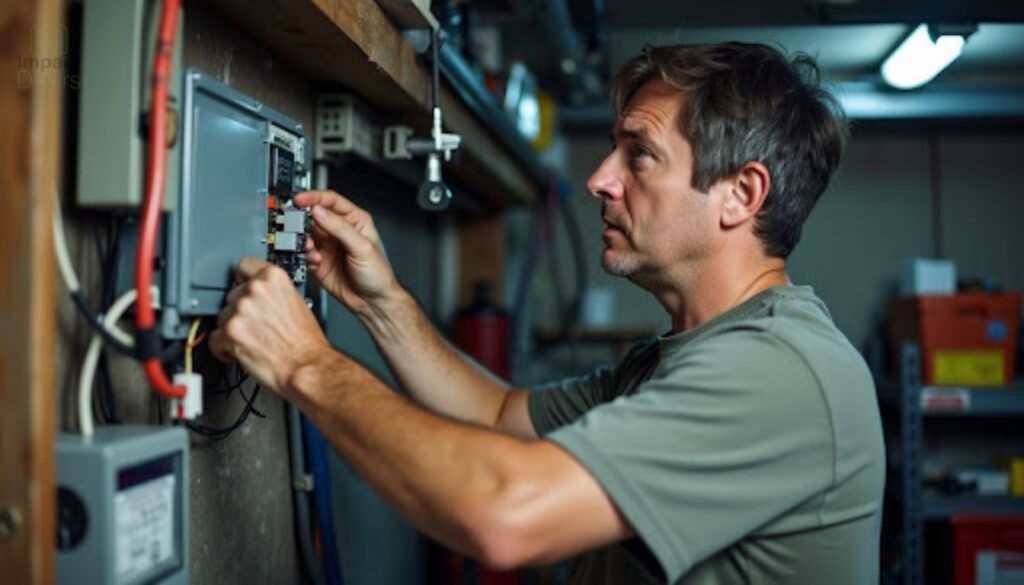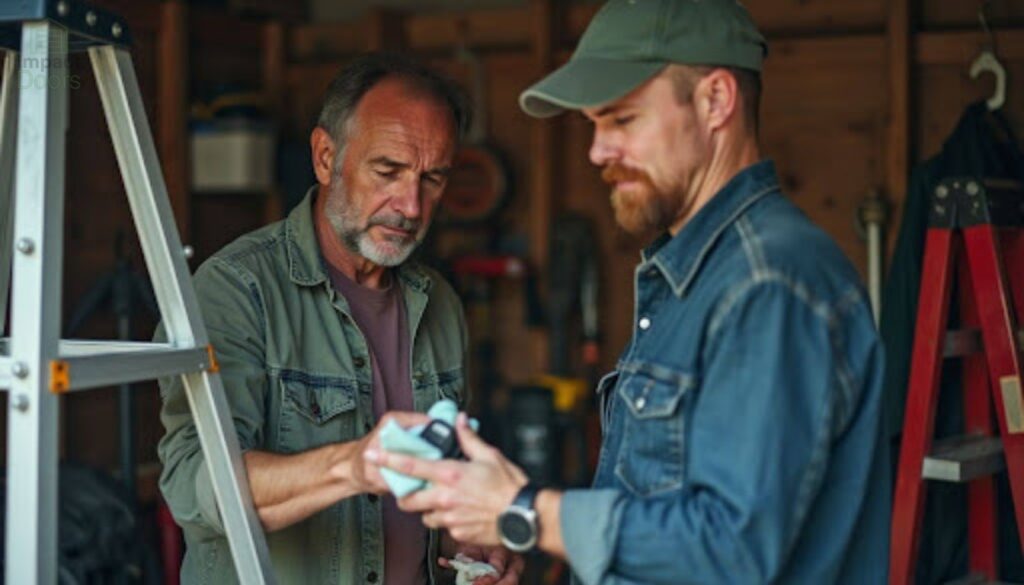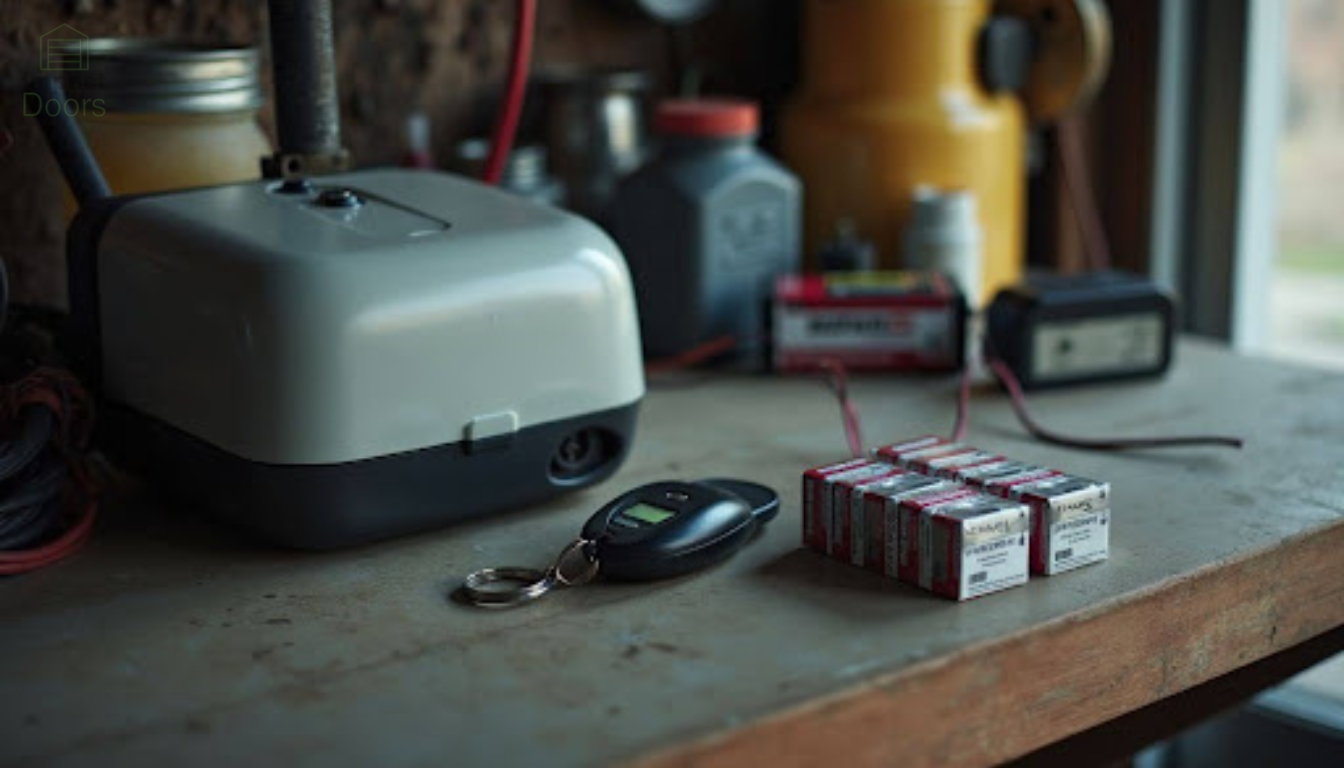Are your garage door opener remotes not working? Dead batteries or RF interference might be the culprits. This article will guide you step-by-step to troubleshoot and fix these issues.
Keep reading for quick solutions!
Key Takeaways
- Check Batteries: Dead batteries are a common issue. Replace them and test if the remote works.
- Clean Contacts: Dirty contacts can block signals. Clean with a cloth or cotton swab.
- Reprogram Remote: Resetting the system often fixes problems. Follow steps to reprogram your remote.
- Inspect Sensors: Misaligned sensors cause issues. Align them properly for smooth operation.
- Seek Expert Help: If self-fixes fail, contact Professional Garage Door Services for advanced help.
Common Reasons Why Garage Door Remotes Stop Working

Garage door remotes can stop working due to simple issues. Below are a few common reasons why this happens, each leading to quick fixes or further diagnostics.
Dead Batteries
Dead batteries are a common reason for a garage door remote to stop working. Hold the remote next to the motor unit and press the button. The LED light should illuminate. If it does not, replace the battery immediately.
Old batteries lose charge fast and may even cause leaks, damaging your remote control’s contacts. This can make your garage door’s response slow or non-existent. Regularly check and change batteries to avoid these issues.
Always keep spare batteries handy.
RF Interference Disrupting Signal
RF interference can disrupt your garage door remote signal. Devices like motion detectors, home alarm systems, and electronic game systems cause this interference. These devices send out radio waves that block the remote’s signal to the receiver.
Move any possible sources of RF interference away from your garage door opener. If problems persist, contact Professional Garage Door Services for help. They can check for other sources of interference and recommend solutions to fix the issue.
Misalignment of Sensors
Misalignment of sensors can cause garage door remote malfunctions. Misaligned sensors disrupt communication between the remote and the opener, leading to inconsistent or non-responsive operation.
Checking for sensor misalignment is a key troubleshooting step. Adjusting and aligning the sensors may resolve many remote control issues. This can get your garage door back in working order quickly.
Worn Out Remote Controls
Remote controls can wear out with time. Continuous use or accidental drops may cause them to stop working properly. If your garage door remote is old, it might be time for a new one.
Try inspecting the buttons on your remote. Worn-out contacts inside the remote can fail to send signals to the garage door opener. Remove any dirt from around these buttons and test again.
Dead batteries are a common reason for garage door remote malfunctions.
Press each button on your remote firmly. Ensure all connections inside work well before deciding it needs replacing.
Step-by-Step Troubleshooting Guide
Follow these steps to fix your garage door remote issues and get it working again.
Check and Replace the Batteries
Garage door remote batteries often die, causing the remote to stop working. Follow these steps to check and replace them:
- Locate the Battery Compartment:
- Find the battery compartment on your garage door remote.
- Open it carefully using a small screwdriver if needed.
- Inspect the Batteries:
- Look at the current batteries for any corrosion or leakage.
- Check their expiration date if possible.
- Remove Old Batteries:
- Take out the old batteries.
- Dispose of them safely following local guidelines.
- Test Remote Without Batteries:
- Hold the remote next to the motor unit and press a button.
- The LED light should not shine since there are no batteries inside.
- Insert New Batteries:
- Place fresh batteries into the compartment.
- Ensure correct polarity (+/-) as indicated inside.
- Close Battery Compartment:
- Securely close the battery cover.
- Use a small screwdriver if required.
- Test Remote Functionality:
- Stand within 20 feet of your garage door opener.
- Press any button on your remote; your door should respond.
- Check Motor Unit Light:
- Hold the remote next to the motor unit again and press a button.
- The LED light should illuminate, signaling that new batteries work.
Following these steps ensures that dead or faulty batteries are replaced correctly, restoring your garage door remote’s functionality quickly and effectively.
Inspect and Clean the Remote’s Contacts
Inspect and clean the remote’s contacts to make sure it works properly. Dirty contacts can be the reason your garage door remote is not working.
- Open the battery compartment of your remote.
- Take out the batteries using a small screwdriver or similar tool.
- Look at the metal contact points inside the compartment.
- If you see dirt or corrosion, rub it off with a clean cloth or cotton swab.
- Use rubbing alcohol on a swab for stubborn dirt, but make sure it is dry before putting back the batteries.
- Check that the contact points are not bent or damaged.
- Reinsert fresh batteries and close the compartment.
Now, test if your remote works. If it still does not work, move on to testing its range and other opener troubleshooting steps.
Test the Range of Your Remote
Test the range of your remote if your garage door opener is not working. Follow these steps to ensure it operates correctly.
- Stand near the opener: Begin close to the motor and press the button on your remote.
- Move away slowly: Walk away while pressing the button. Note where the door starts failing to respond.
- Check for interference: Look for devices like motion detectors or electronic games that might block the signal.
- Replace dead batteries: Ensure batteries are fresh if there is no LED light when you press a button.
- Unplug and reset system: Unplugging the garage door opener for one minute may fix glitches in the system.
- Reprogram your remote: Use the learn button on your control panel to reprogram your remote.
These steps will help determine if range issues are due to weak signals or another problem with your garage door system.
Reset the Garage Door Opener System
Resetting the garage door opener system can fix many issues. Follow these steps to reset it properly:
- Unplug the Opener: Disconnect the power by unplugging the unit from the outlet. Wait for about one minute.
- Plug Back In: Reconnect the power by plugging the unit back into the outlet.
- Locate the Learn Button: Find and press the learn button on your opener’s control panel.
- Hold Button: Hold this button for about six seconds until you see an LED light turn off.
- Reprogram Remote: Press and hold your remote button while pressing the learn button again until you see a blinking light.
- Test Operation: Test if your garage door responds to your remote now.
- Consult Professional Help: If these steps do not work, contact Professional Garage Door Services for further assistance.
Reprogram the Remote to the Opener
To get your garage door remote working again, reprogram it to the opener. Reprogramming aligns the remote with your door system.
- Locate the Opener’s Learn Button
Find the “learn” button on your garage door opener. It is often near the antenna or radio receiver. - Press and Hold the Learn Button
Press this button for about 10 seconds until an LED lamp lights up. This clears old settings. - Press a Button on Your Remote
Within 30 seconds, press a button on your remote control. The garage door motor should blink or click. - Test the Remote
Check if your remote now opens and closes the garage door from different spots in your driveway. - Consult User Manual if Needed
If you face issues, look at the user manual or contact customer service for help. - Check for RF Interference
Ensure no electronic devices disrupting signals are close by, such as radios or LED lamps. - Seek Professional Help if Problems Persist
If reprogramming fails, consider contacting Professional Garage Door Services for further assistance or replacement parts.
Reprogramming often fixes common issues like RF interference and system resets with ease.
Advanced Issues and Solutions

Advanced Issues and Solutions: Fix complex problems with the garage door opener by checking its electrical system, sensors, and frequency settings.
Dealing with Electrical Issues in the Opener
A faulty power source can stop your garage door opener from working. Ensure the unit is plugged in firmly and check for any tripped circuit breakers. Sometimes, a simple reset can fix the problem.
Unplug the opener for one minute and then plug it back in to see if it works.
Inspect wiring around the motor and control panel for wear or damage. If wires appear frayed or loose, they may need replacing by a professional garage door technician. This company offers quick handyman services to deal with such issues.
Professional Garage Door Services responds promptly and resolves electrical problems effectively.
Eliminating RF interference involves turning off other electronics like motion detectors nearby that may disrupt signals between your remote and opener’s receiver module.
Realigning Infrared Sensors
Sometimes garage door remotes stop working due to misaligned infrared sensors. Follow the steps below to realign the sensors safely and correctly:
- Turn off the Power: Switch off the power to the garage door opener. This ensures safety while working with electrical parts.
- Inspect Sensors: Check both sensors located at the base of each side of the garage door frame. Ensure they are clean and free from debris.
- Position Sensors: Adjust the sensors so they face each other directly. Both should be aligned at a height of 4-6 inches from the ground.
- Check for Lights: Look for indicator lights on both sensors. A steady light means proper alignment, while a blinking or no light means misalignment.
- Secure Mounts: Tighten any loose screws or brackets holding the sensors in place to maintain their position.
- Test Door Operation: Restore power and test the garage door opener with your remote control to see if it works smoothly.
- Address Interference: Ensure there are no objects blocking the sensor’s path or causing interference, such as new electronic devices.
- Professional Help: If issues persist, consult Professional Garage Door Services for further assistance and potential replacements.
Addressing Frequency Conflicts
Frequency conflicts can occur due to nearby devices. Sources include motion detectors, home alarm systems, and electronic game systems. These can block your garage door remote’s signal.
First, identify if you have new electronics in the area. If so, try moving them or turning them off temporarily. Also, ensure the antenna of your garage door opener is fully extended and not damaged.
For persistent issues, contact Professional Garage Door Services for expert help.
Preventive Maintenance Tips

Keep your garage door remotes and sensors clean for better performance. Check the batteries regularly to avoid unexpected issues.
Regular Cleaning of Remotes and Sensors
Dust and grime gather on remotes and sensors over time. This can block signals and cause problems with the garage door opener. Clean both monthly to avoid issues. Wipe the remote with a damp cloth to remove dirt.
Use a soft brush on sensors to clear any debris.
Regular cleaning helps prevent dead batteries from working harder due to poor contact points. Always ensure no obstructions exist near sensors for smooth operation. Routine checks keep your garage door running well.
For best results, perform these steps along with checking battery life regularly.
Routine Checks on Battery Life
Check the LED light on your garage door remote. It should illuminate when you press the button. Hold the remote next to the motor unit to verify this.
Replace the battery if the light does not turn on. Do this routine check every six months, especially if your garage door won’t respond properly.
Scheduled Professional Maintenance Visits
Schedule professional maintenance visits for your garage door to ensure it runs smoothly. Contact Professional Garage Door Services for regular check-ups. Technicians can spot issues early and fix them before they become big problems.
These services often come with excellent warranties, adding peace of mind. Routine checks on battery life and cleaning sensors can prevent many common remote control issues. Regular maintenance keeps your door operational and prevents frequent malfunctions, leading to a longer-lasting system.
Next: When to Consider a Replacement
When to Consider a Replacement
Think about replacing your garage door remote if it keeps failing. Also, consider a new one for better security features.
Age and Obsolescence of the Current System
Garage door openers, like the Liftmaster 1/2HP model, can become less reliable over time. Frequent problems with remote controls often mean the system is getting old. If your garage door opener keeps failing or faces constant malfunctions, it may be time to replace it.
Older systems might also lack new security features. Upgrading to a modern opener improves safety and functionality. Newer models offer better technology and reduce downtime. Consider replacing outdated equipment for smoother operation and peace of mind.
Frequent Malfunctions and Downtime
Frequent malfunctions can indicate the need for a new garage door opener. Issues like dead batteries, RF interference, and worn-out remotes may happen often.
Downtime might result from old systems. Malfunctions disrupt daily routines and security. Consider upgrading if problems persist even after replacing batteries or resetting the system.
Upgrading for Enhanced Security Features
Upgrade your garage door remote for better security. New models offer encrypted signals to prevent hacking. PGDS, with 25 years of experience, can help you choose the right upgrade.
Technicians like Ryan and Tony are known for their professionalism and prompt service.
Enhanced remotes also feature rolling codes that change each time you use them. This makes it harder for thieves to copy your signal. Look into these options if your old remote often malfunctions or lacks modern features.
Next: How to Choose a Replacement Remote
How to Choose a Replacement Remote
Make sure it is compatible with your current garage door system and has the features you need.
Compatibility with Existing System
Your new remote must work with your existing garage door opener. Check the model number of your current system first. Many remotes have a list of compatible openers in their manuals or on the box. If you’re unsure about compatibility, consider investing in a universal remote for garage doors, as these are designed to work with a wide range of models. Be sure to follow the programming instructions carefully to sync it with your opener. This option provides convenience and flexibility, especially if you have multiple garage doors or systems.
Professional Garage Door Services offers remotes that match various brands and models. Matching ensures smooth operation without issues like signal loss or malfunction. This step will save you time and frustration later on.
Next, explore “Features and Security Enhancements.
Features and Security Enhancements
Modern garage door remotes offer more than just convenience. They provide advanced security features to keep your home safe. Some models use rolling code technology, which changes the code each time you use the remote.
This prevents hackers from duplicating your signal.
New remotes also often come with extra buttons for different functions, like turning on lights or activating a lock mode for extra security when you are away. Enhanced range and reduced interference help ensure that your garage door opens smoothly every time.
Brand and Manufacturer Support
Good support from a brand can make a big difference. Professional Garage Door Services offers excellent warranties. You can contact Ryan at 0411287440 or Tony at 0417970011 for help.
Choosing well-known brands ensures better service and quality parts. Brands like LiftMaster, Genie, and Chamberlain are popular for their reliable products. They often have good customer service and warranty options.
Conclusion
Fixing a garage door remote can be simple. Start with checking the batteries and range. Clean the contacts if needed. If these steps don’t work, try resetting or reprogramming the system.
Regular maintenance ensures your remote works longer. For tough issues, consult experts like Professional Garage Door Services in Perth for help.
Garage Door Opener Service Near You
Experiencing garage door troubles? Count on Jarred and the expert team at Impact Doors for fast, reliable repairs. Our dedication to top-quality service will have your garage door opener working perfectly in no time. Call us today at (07) 5451 4022 for professional assistance.

